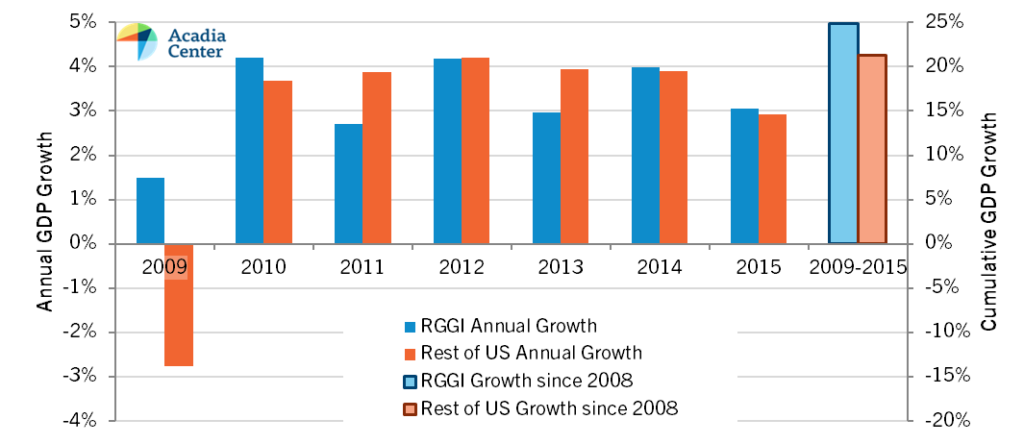RGGI Experience Suggests CPP Concerns Are Overblown
The EPA’s Clean Power Plan (CPP)¹ is a groundbreaking regulation to combat climate change. Despite popular support for the rule, this first federal action to reduce carbon emissions from existing power plants has been met with considerable pushback in some quarters. The rule’s opponents most frequently cite three talking points, saying the CPP could 1) cause electricity prices to rise, 2) be a job killer, and 3) lead to economic stagnation.
These concerns will sound quite familiar to the states participating in the Regional Greenhouse Gas Initiative (RGGI), which launched in 2009. As the nation’s first market-based program to reduce carbon emissions, RGGI had plenty of detractors who used the same arguments as those currently being directed at the CPP. Now, with seven and a half years of RGGI experience to analyze, we can assess how the program has actually performed. As discussed in more detail in Acadia Center’s upcoming RGGI report, the early fears about RGGI’s impacts on electricity prices, jobs, and the economy should be put to rest. The figures below illustrate some of the key findings from RGGI’s operation to-date.
Electricity prices
By choosing to hold power plant owners responsible for the carbon they emit (rather than allowing them to pollute for free), the RGGI states accepted that it would become more expensive for fossil-fueled power plants to generate electricity. That, in turn, could result in higher electricity prices. But as shown in the table below, average retail electricity prices in the RGGI states actually declined by 3.4% from 2008 (the year before RGGI began) to 2015.2 The emergence of low-cost natural gas undoubtedly played a role in this trend, but so too have RGGI-funded investments in energy efficiency and renewable energy, both of which reduce demand for carbon-intensive electricity generation and reduce prices.
RGGI State Electricity Prices, 2008 and 2015 (Cents/kWh)

Employment
Despite claims that RGGI would cost the region jobs by driving businesses away, the program has actually made a significant contribution to employment in the RGGI states. Independent analysis determined that RGGI was responsible for creating 28,500 job-years through 2014. Some of these jobs are the direct result of clean energy projects funded with RGGI auction revenue, and investments in energy efficiency and renewable energy have enabled clean companies to scale up their operations, creating new, high quality jobs for the local workforce. Additional jobs are created as consumers spend energy bill savings in local economies.
Economic stagnation?
Far from stagnating in comparison to the rest of the country, the economies of the RGGI states have outpaced growth in other states’ economies since the program launched in 2008. Over the same time period, RGGI emissions declined by 37%. The combination of economic growth with declining emissions witnessed in the RGGI states is both groundbreaking and a trend that is likely to spread as additional states adopt market-based climate programs like RGGI. Historically, electricity demand has been linked to economic growth, and electric sector emissions have increased during periods of economic expansion. However, this correlation has been broken in the RGGI region. As shown in the table below, economic growth in the RGGI states has exceeded growth in the rest of the country even as the RGGI states have surpassed their ambitious climate goals. Additionally, macroeconomic analysis of RGGI’s impact through 2014 shows that the program added nearly three billion dollars in net economic benefits for the region.
GDP Growth Rates in RGGI States versus Other States
RGGI’s experience has demonstrated that a well-designed, market-based program can achieve environmental goals and drive economic growth. Emissions reductions under RGGI have come at far lower than expected costs, and the clean energy sector and economy as a whole have been boosted by the reinvestment of allowance revenue into energy efficiency and renewable energy programs. RGGI’s experience shows the actual impact of smart climate policy in practice. Before heeding dire predictions of potential impacts of the CPP, it is worth keeping this real-world experience in mind.
Stay tuned for our upcoming RGGI report with the latest on market trends, the RGGI program review, and the CPP.
1 The Supreme Court issued a stay on the Clean Power Plan in February, 2016, but as discussed in an earlier blog post, we expect the stay to be lifted and the Clean Power Plan to be enforced.
2 Energy Information Administration (EIA) 826 Dataset, http://www.eia.gov/electricity/data/eia826/


















